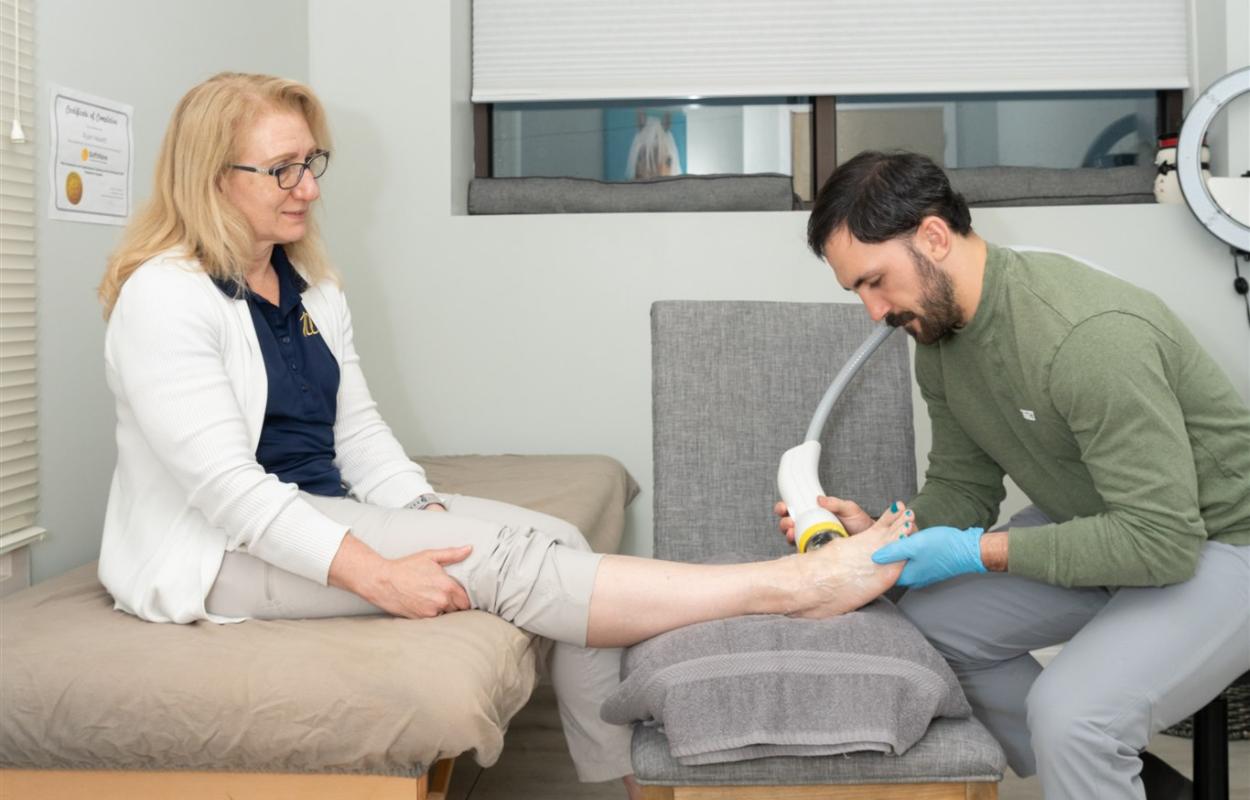Causes, Symptoms, and Treatment
Plantar fasciitis is a widespread and often debilitating foot condition that affects millions of individuals globally. It is characterized by intense pain experienced in the heel and the underside of the foot, particularly around the arch area. The root cause of this condition lies in the inflammation or irritation of the plantar fascia, a robust band of tissue that connects the heel bone to the toes. Plantar fasciitis can be particularly troublesome, as it often manifests as a sharp, stabbing pain, especially during the first steps taken in the morning or after long periods of inactivity.
Exploring the Diverse Causes of Plantar Fasciitis
Plantar fasciitis can develop from a variety of causes, and understanding these factors is crucial for effective treatment and prevention:
Overuse and Repetitive Stress
Prolonged periods of standing, walking, or running can lead to overuse and repetitive stress on the feet, which may trigger plantar fasciitis. Activities that involve repetitive foot motions, such as long-distance running or occupations requiring extended periods of standing, can increase the risk.
Improper Foot Mechanics
The structure of one’s feet plays a significant role in plantar fasciitis development. Individuals with flat feet or high arches are more prone to developing this condition, as these conditions can lead to abnormal stress on the plantar fascia.
Footwear Choices
Wearing shoes that lack proper arch support or have worn-out soles can contribute to plantar fasciitis. Inadequate footwear fails to provide the necessary cushioning and support, increasing the strain on the plantar fascia.
Excess Weight and Obesity
Carrying excess body weight can place increased pressure on the feet, which can strain the plantar fascia. Obesity is a significant risk factor for developing plantar fasciitis.
Specific Activities and Occupations
Certain activities or occupations that involve repetitive foot movements on hard surfaces, such as ballet, dance, or working on concrete floors, can contribute to plantar fasciitis development.

The Complexity of Plantar Fasciitis Symptoms
The symptoms of plantar fasciitis can vary in intensity and duration from person to person. Understanding these symptoms is essential for both diagnosis and management:
Sharp or Stabbing Heel Pain
The hallmark symptom of plantar fasciitis is sharp or stabbing pain, typically felt in the heel or along the arch of the foot. This pain can be particularly excruciating when taking the first steps of the day.
Aggravation with Activity
Pain associated with plantar fasciitis often intensifies during activities that involve standing, walking, or running. This makes it challenging for affected individuals to engage in everyday routines without discomfort.
Stiffness and Discomfort
After periods of rest, such as after a night’s sleep or a prolonged period of sitting, individuals with plantar fasciitis may experience stiffness and discomfort in their feet. These symptoms can make the initial steps of the day especially painful.
Tenderness and Inflammation
The bottom of the foot, particularly the area around the heel and arch, can become tender and inflamed in those with plantar fasciitis.
Pain Patterns
Plantar fasciitis often exhibits pain patterns where discomfort temporarily improves with activity but returns after resting. This pattern can create a cycle of pain and frustration for those affected.
Chiropractic Care for Plantar Fasciitis
Chiropractic care offers a holistic and comprehensive approach to treating plantar fasciitis. By addressing the root causes of the condition, chiropractors aim to provide relief, improve foot health, and enhance overall well-being. Here are some key aspects of chiropractic treatment for plantar fasciitis:
1. Spinal Adjustments
Chiropractors perform spinal adjustments to correct misalignments in the spine. These adjustments not only relieve pressure on the nerves but also improve overall body function. Proper spinal alignment can have a positive impact on foot mechanics, reducing stress on the plantar fascia.
2. Soft Tissue Therapy
Various soft tissue techniques, including myofascial release and the Graston Technique®, can be employed by chiropractors to release tension and adhesions in the muscles and fascia of the foot. These therapies aid in reducing inflammation and promoting the healing process.
3. Foot Orthotics
Custom-made orthotic inserts may be prescribed by chiropractors to provide the necessary support and alignment for the feet. Orthotics can help distribute pressure evenly across the foot, reducing strain on the plantar fascia.
4. Stretching and Strengthening Exercises
Chiropractors may recommend specific exercises designed to stretch and strengthen the muscles and fascia of the foot. These exercises improve foot mechanics, reduce pain, and can serve as a preventive measure against future injuries.
The Unique Benefits of Chiropractic Care for Plantar Fasciitis
Choosing chiropractic care for plantar fasciitis offers several distinctive advantages:
- Individualized Treatment: Chiropractors understand that each patient is unique, and they tailor their treatment plans to address the specific needs and root causes of each case of plantar fasciitis.
- Non-Invasive Approach: Chiropractic care prioritizes natural, non-invasive treatments to alleviate pain and facilitate healing. This approach minimizes the need for medication or surgical interventions whenever possible.
- Root Cause Addressed: Chiropractors focus on identifying and addressing the root cause of plantar fasciitis rather than merely treating its symptoms. This comprehensive approach ensures long-term relief and prevention.
- Holistic Perspective: Chiropractors view the body as a interconnected system, recognizing that imbalances or misalignments in one area can impact other parts of the body. By addressing overall spinal health and foot mechanics, chiropractors provide comprehensive care for plantar fasciitis.
If you are grappling with heel pain or suspect you may have plantar fasciitis, seeking chiropractic care can provide an effective, natural path to relief. At In8 Wellness Center in North Andover, MA, our seasoned chiropractors specialize in treating plantar fasciitis and a range of musculoskeletal conditions. Our personalized treatment plans target the root causes of your pain, helping you achieve sustained relief and improved foot health.
Don’t allow plantar fasciitis to hinder your daily activities any longer. Reach out to In8 Wellness Center today to schedule an appointment and embark on the journey toward a pain-free life. Your feet will thank you for taking this proactive step towards optimal foot health.
Frequently Asked Questions
1. What is plantar fasciitis, and how does it affect the foot?
Plantar fasciitis is a common foot condition characterized by inflammation and pain in the plantar fascia, a thick band of tissue that runs along the bottom of the foot, connecting the heel to the toes.
2. Can chiropractic care help with the treatment of plantar fasciitis?
Chiropractic care may offer relief from plantar fasciitis symptoms by addressing biomechanical issues, such as misalignments in the feet or spine, that can contribute to the condition.
3. Is chiropractic care safe for individuals with plantar fasciitis?
Chiropractic care is generally safe when administered by a licensed chiropractor. However, it’s essential to have a proper diagnosis to ensure that plantar fasciitis is the cause of your foot pain.
4. What chiropractic techniques are commonly used for plantar fasciitis?
Chiropractors may use techniques such as adjustments, soft tissue therapies, and stretches to alleviate pain, reduce inflammation, and improve foot function in individuals with plantar fasciitis.
5. How many chiropractic sessions are typically needed to manage plantar fasciitis?
The number of sessions required varies depending on the severity of plantar fasciitis and individual response to treatment. Some people experience relief after a few sessions, while others may need ongoing care.
6. Can chiropractic care cure plantar fasciitis?
Chiropractic care primarily focuses on managing and alleviating the symptoms of plantar fasciitis, rather than curing the condition itself. Long-term management and preventive measures are often necessary.
7. What other treatments can complement chiropractic care for plantar fasciitis?
Chiropractic care can be combined with other treatments, such as physical therapy, custom orthotics, stretching exercises, and lifestyle modifications, for more comprehensive plantar fasciitis management.
8. Is chiropractic care suitable for all cases of plantar fasciitis?
Chiropractic care can be beneficial for many individuals with plantar fasciitis, but the suitability of treatment depends on the specific characteristics of the condition and the patient’s overall health.
9. Should I consult with a podiatrist or orthopedic specialist in addition to a chiropractor for plantar fasciitis?
It’s often advisable to consult with a healthcare provider who specializes in foot and musculoskeletal conditions, such as a podiatrist or orthopedic specialist, to ensure a comprehensive and tailored approach to managing plantar fasciitis.
10. What sets In8 Wellness Center apart for plantar fasciitis care in North Andover, MA?
We offer a non-invasive, customized approach to plantar fasciitis relief, with the goal of providing both immediate and long-term benefits to our patients.
